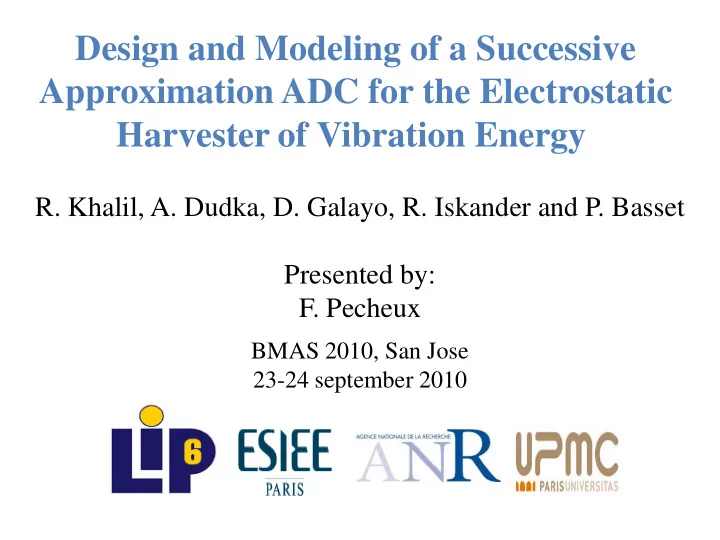

Design and Modeling of a Successive Approximation ADC for the Electrostatic Harvester of Vibration Energy R. Khalil, A. Dudka, D. Galayo, R. Iskander and P. Basset Presented by: F. Pecheux BMAS 2010, San Jose 23-24 september 2010
Outline • Introduction – Harvester operation – Smart power management – Work goals • Successive Approximation ADC – SAR ADC Architecture – SAR ADC Modes – Comparator – DAC and SAR Control 2
Outline • SAR ADC into The Harvester Conditioning Circuit – Calibration technique – Model Results • Conclusion 3
Introduction Trains Cars Aircrafts Ambient mechanical vibrations Human Industrial tools body 4 Environment surveillance Vibrating structures
Harvester Operation • U store increases quickly –average power increases and becomes maximal •U store saturates –average power 5 decreases and drops to zero.
Harvester Operation • Power converted is bounded between two limits U 1 and U 2 . •Power converted must be stored in C res . • The output power of the harvester equals 20 uW when 6 Ustore=50V.
Smart Power Management • Commutation parameters U 1 and U 2 are calculated with empirical formula. • U1 and U2 depends on the initial voltage U res and Ustore in 7 saturation.
Smart Power Management • Calibration cycles are needed • Analog to Digital Converter is needed 8
Work Goals • Create an interface between the harvester and the smart power management. • Measure initial voltage U res and U store in saturation to calculate U 1 and U 2 • Calibration mode. • Estimate the power consumption of this interface. 9
Successive Approximation ADC • The successive approximation ADC is known as one of the best candidates in terms of low power • The model contains VHDL-AMS block and ELDO netlist blocks using 0.35um AMS technology 10
Successive Approximation ADC Architecture • The signal is sampled by the DAC • DAC output is compared with U cm • The Comparator output is connected to SAR control. • SAR controls the switches in the DAC • 3 references used: U dd , U cm =U dd /2 and gnd. • SAR ADC modes: sampling mode, inversion mode and charge 11 redistribution mode
Successive Approximation ADC Modes • The sampling mode: • In the first half of the first clock cycle. • DAC Bottom plates are connected to U in . • DAC upper plates are connected to U cm . • U dacTop =U dd /2 • The inversion mode: • In the second half of the first clock cycle • DAC Bottom plates are connected to U cm • U dacTop =U dd –U in • The output of the comparator represents the MSB 12
Successive Approximation ADC Modes • The charge redistribution mode: • In the next N clock cycles. • Depending on the Comparator, the SAR control connects the DAC bottom plates to U dd or gnd. • At the end of the charge redistribution mode, the digital output bits correspond to input signal . • The SAR ADC used in the harvester conditioning circuit: • 8 bits • Ts=3.6ms and internal clock=2.5Khz 13
Comparator • The comparator is designed using 0.35um technology (AMS035). • Udd=2.5V • The comparator is the only analog part in the SAR ADC architecture. • It is a semi-dynamic clocked architecture. • The transistors M1 and M2 are used to amplify the input signal. • The transistors M3, M4, M9 and M10 implement a couple of 14 inverters connected to be a flip-flop.
DAC and The SAR Control • The DAC netlist: • Total capacitance=(2 N-1 )C u • Binary weighted capacitor array. • SAR control VHDL-AMS Model: • Produces the control signals for the switches during the 3 modes. • Produces the output bits at the end of each conversion 15
SAR ADC into The Harvester Conditioning Circuit • The SAR ADC input is U sotre divided by 20 (U store max /U dd ). • SAR ADC output bits are connected to the Flyback switch control. • Flyback switch control enables the SAR ADC only in the calibration cycle. • The Calibration cycle repeats rarely. 16 • The whole harvester system model is mixed
Calibration Technique • Calibration is started. • Measuring initial voltage U res . • Measuring U store in saturation. • Resolution=(2.5/2 8 ).20= 0.2 V. • Flyback disables the SAR ADC. • U 1 and U 2 are calculated. 17 • Normal cycles are started.
Model Results • Example: long time simulation 11 s. • Calibration cycle repeated every 900ms. • U res is measured at the beginning of every calibration cycle. • U res increases during normal mode. 18
Conclusion • Interface between the Harvester conditioning circuit and the flyback control is done. • The estimated power consumed of the SAR ADC is 1.25uW in one step conversion and the average power consumption equals to 180nW. ― The comparator is the dominant block in terms of power consumption. • Calibration technique is implemented to achieve optimal electromechanical conversion . 19
Thank you
Recommend
More recommend